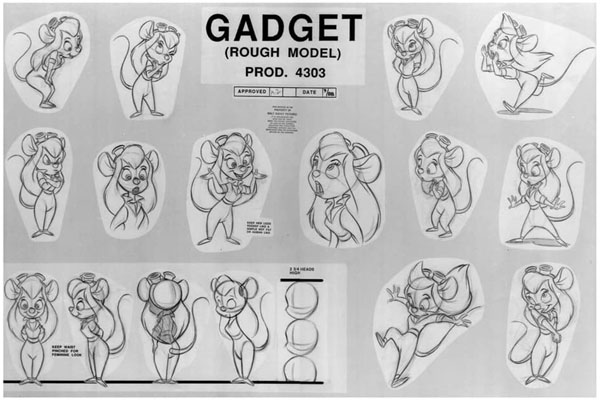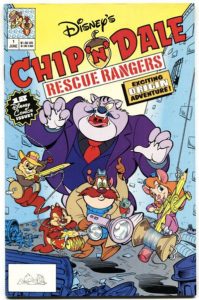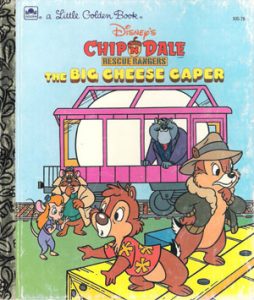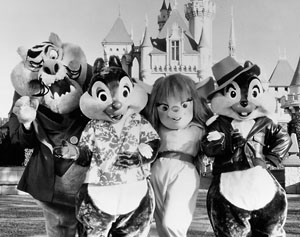Suspended Animation #280

“Sometimes some crimes go slipping through the cracks
“But these two gumshoes are picking up the slack
“There’s no case too big, no case too small
“When you need help just call
“Ch-ch-ch- Chip ‘n’ Dale, Rescue Rangers”
That Chip ‘n’ Dale’s Rescue Rangers theme song that some consider an “ear worm” because you can’t get it out of your head once you hear it was written by Mark Mueller who also composed the theme song for Duck Tales.
I’ve always loved that theme song and have fond memories of babysitting my niece and watching the Disney Afternoon shows while waiting for my brother or his wife to come by and pick up their daughter after they got off work.
 The concept of a block of syndicated Disney animation programming known as the “Disney Afternoon” didn’t become official until Tale Spin premiered but the success of Duck Tales on television prompted the Disney Company to look at other possible original animated television shows to produce.
The concept of a block of syndicated Disney animation programming known as the “Disney Afternoon” didn’t become official until Tale Spin premiered but the success of Duck Tales on television prompted the Disney Company to look at other possible original animated television shows to produce.
After Duck Tales, Disney was seriously considering producing a syndicated television series based on The Rescuers (1977). However, when Jeffrey Katzenberg also re-discovered the simple delights of The Rescuers and that Disney still retained the rights to the stories, he green-lit the production of the first Disney animated film sequel The Rescuers Down Under (1990) and then some adjustments had to be made to the property that was slated for television development.
Supervising Story Editor Tad Stones and his team, including co-creator Alan Zaslove, took the core premise of small animals as heroes in the world of humans and came up with a program titled “Metro Mice”, a take-off on the title of the popular detective television series, Miami Vice.
The main characters would have been Kit Colby (a mouse wearing an Indiana Jones jacket and hat who was the adventurous leader of the team), Colt Chedderson (a burly Australian kangaroo rat and explosives expert), Gadget (a blonde female mouse who was an inventor), Chirp Sing (an Oriental cricket who loved baseball and martial arts), Camilla (a chameleon and the team secretary) and Eagle Eye (a near-sighted eagle who was the team’s lookout).

In an excellent three-part 2004 career interview with John Strike for Animation World Network, Stones remembered the pitch meeting for the show to Michael Eisner and Katzenberg.
“They went: ‘We love the idea of the show, but your main character doesn’t have it.’ The meeting went on a little longer and we’re saying Duck Tales is a big success, what other Disney characters can we work with? You don’t want to do Mickey or Goofy, but there’s Pluto and all that. Finally, I said, ‘There’s Chip and Dale.’
 “Eisner said, ‘Great — put those guys in that show,’ and Jeffrey says ‘home run.’ That’s why Chip and Dale’s Rescue Rangers got done. It changed our development, because now instead of one hero you have this dynamic, which was well established and gave us lots of stories about how they interacted with other characters.”
“Eisner said, ‘Great — put those guys in that show,’ and Jeffrey says ‘home run.’ That’s why Chip and Dale’s Rescue Rangers got done. It changed our development, because now instead of one hero you have this dynamic, which was well established and gave us lots of stories about how they interacted with other characters.”
Chip inherited Kit Colby’s Indiana Jones attire and love of adventure and Dale, who was to be more lighthearted when it came to danger, was given a Hawaiian shirt perhaps influenced by the then-popular television detective show Magnum, P.I.
Colt Chedderson transformed into the cheese addicted Monterey Jack. Gadget was retained while the other animal characters were abandoned. Zipper the housefly inspired by Evinrude the dragonfly in the original animated film The Rescuers was added to perform similar functions such as flight and a power source.
There is a huge fandom for the series of the Disney Afternoon block and in particular, Chip and Dale’s Rescue Rangers and, in particular, the character of Gadget which may be why the children’s roller coaster at Disneyland was inspired by her.
On August 2nd, 1988, a movie-length version, Chip’n’Dale’s Rescue Rangers to the Rescue, was aired on the Disney Channel. It was structured so the film could be broken up into five episodes on the regular series, although when that did happen there were changes made so there were scenes both added and cut in the five episodes.
 To the Rescue is an “origin” story of how the Rescue Rangers were first formed and got their name and some back story information on the characters, including the fact that Gadget was the daughter of one of Monty’s old friends who had died a year earlier.
To the Rescue is an “origin” story of how the Rescue Rangers were first formed and got their name and some back story information on the characters, including the fact that Gadget was the daughter of one of Monty’s old friends who had died a year earlier.
On March 5th, 1989, Season One of the show premiered on the Disney Channel with Piratsy Under the Seas as the first episode. Beginning September 1989, the series was added to The Disney Afternoon syndicated line-up.
On November 19th, 1990, They Shoot Dogs, Don’t They? was the last original episode to have its premiere with the show going into reruns of its 65 produced episodes for the next few years. In 1993, the show was taken off The Disney Afternoon block and replaced by Bonkers, an attempt by the Disney Company to create a Roger Rabbit-like character that was fully owned by Disney.
According to the original press release from 1989:
“Chip ’n’ Dale’s Rescue Rangers is a half-hour of broad comedy and adventure with large doses of mystery, featuring two of Disney’s most popular primary characters. Chip and Dale head a small, eccentric group of animal characters who monitor not only the ‘human’ world, but the animal community as well, solving mysteries wherever they may be.

“Although those cases may seem small to start with, they invariably lead to crimes and mysteries of much greater proportions. The local police are either too busy for problems like these or they are out of police jurisdiction.”
Growing up in Southern California, I was lucky enough in 1991 to see the very short-lived “Disney Afternoon Avenue” that was in the area in front of “it’s a small world” attraction at Disneyland and to see the live-action Videopolis Plane Crazy stage show where costumed characters Rescue Rangers Chip and Dale, Launchpad McQuack, and Talespin Baloo try to retrieve a secret plane stolen by Don Karnage and Fat Cat.
Yes, Uncle Jim took his niece and she loved it. Now she is old enough to have two daughters of her own. However, when I hear that familiar theme song, I immediately remember those afternoons when it was truly a Disney Afternoon.



 Jim Korkis is an internationally respected animation historian who in recent years has devoted his attention to the many worlds of Disney. He was a columnist for a variety of animation magazines. With his former writing partner, John Cawley, he authored several animation related books including The Encyclopedia of Cartoon Superstars, How to Create Animation, Cartoon Confidential and Get Animated’s Animation Art Buyer’s Guide. He taught animation classes at the Disney Institute in Florida as well as instructing classes on acting and animation history for Disney Feature Animation: Florida.
Jim Korkis is an internationally respected animation historian who in recent years has devoted his attention to the many worlds of Disney. He was a columnist for a variety of animation magazines. With his former writing partner, John Cawley, he authored several animation related books including The Encyclopedia of Cartoon Superstars, How to Create Animation, Cartoon Confidential and Get Animated’s Animation Art Buyer’s Guide. He taught animation classes at the Disney Institute in Florida as well as instructing classes on acting and animation history for Disney Feature Animation: Florida.




















































I didn’t have TV in the late ’80s, so I used to hang out with a friend who did and watch the new Disney cartoons, which were much better than the cheesy animated toy commercials prevalent in that decade. It was easy to figure out the corporate thinking behind these shows: just take a couple of established, trademarked characters, and then shoehorn them into a trendy, updated setting. “Great idea, boss!”
The pattern was so obvious that, just for laughs, we used to come up with ideas for modern Disney cartoons, like a rip-off of “Moonlighting” starring Lady and the Tramp. We wanted Disney to make a cartoon with Tinker Bell as a Madonna-type pop star who was also a spy, which she could do because none of the millions of fans who had seen her music videos had any idea that she was only six inches tall! She also had to deal with the jealousy of the anonymous singer who recorded her tracks, because Tink, being mute, could only lip-sync like Milli Vanilli.
When my friend moved away in the early ’90s, he gave me his TV set. It was nice being able to watch whenever I wanted, but it was also a lot less fun.
Now, “Maximum Horsepower” — that’s a Disney Afternoon show I really wish had been made.
That Tinkerbell idea is BRILLIANT.
I was already past the Disney Afternoon’s target demographic when “Duck Tales” arrived but I was a pretty steady viewer of that and “Tale Spin”. “Duck Tales” especially was the show I wanted when I was a kid: the comic books brought to life with decent production values. Also, I grew up in an era when Disney was very stingy with its cartoons. Try to imagine when World of Color was the ONLY chance you had to see Disney animation outside a theater, aside from a silent 8mm reel.
My first glimpse of “Duck Tales” came from a business magazine article about Michael Eisner: a promo image of Uncle Scrooge in his money bin and a mention he’d be starring in a syndicated animated show. The show wasn’t exactly what I’d hoped for, but it was the high water mark until “Batman: The Animated Series” (which, with its follow-ups through “Justice League Unlimited”, was everything those Filmation and HB Saturday morning shows weren’t).
“Rescue Rangers” wasn’t quite as big a deal, as I was never as invested in the chipmunks. But I do remember stumbling into an episode about a quasi-religious cult built around a soft drink commercial. It was of course rendered cute and harmless, but at a time when real-life cults were in the news an interesting concept for a cartoon to wrestle with.
Pointing out one bit of misinformation with this post. I’m positive the “To The Rescue” TV movie did not air until the Fall of 1989. What did air in 1988 as a sneak preview was “Catteries Catteries Not Included”, the first episode produced. That episode and the ones that aired in the Disney channel in the Spring of 1989 were all the very earliest episodes and were all animated by TMS. The five part “To The Rescue” story was later in the production run, and I don’t believe it would have been anywhere near ready in 1988.
Always great to read a piece by Jim Korkis.
I always felt that Rescue Rangers worked in a way that Tale Spin did not for this reason: Chip and Dale had already used man made objects in the theatrical cartoons, so this was an extension of that. Putting Baloo in Tale Spin – in a human-like society as an airplane pilot, no less – took him too far away from his established environment and character. Your mileage may vary 😁
In Russia, some fans have created a “cult” around the character Gadget Hackwrench, where she is worshipped for her sweetness and her inventiveness.
That is cool that they did that in Russia made an occult appearance of Gadget Love From Chip and Dale Rescue Rangers. They should have done it with the entire cast which would’ve been a really great and a lot more cooler and called it Chip and Dale Recuse Rangers The Occult Group. But however that is more own personal opinion about it. I really do remember growing up on watching a lot of those eighty and ninety cartoon shows when I was a kid so I really do remember all of them that I have watched when growing up.